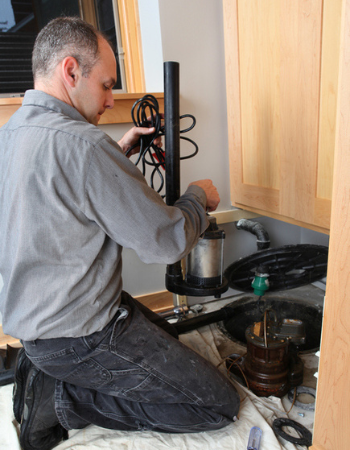We may earn revenue from the products available on this page and participate in affiliate programs. Learn More ›
Q: Lately, my sump pump has been making weird noises, and today it’s been cycling on and off. Why is my sump pump not working? How can I fix it?
A: A sump pump is a critical component of many homes that removes excess water from areas such as basements and keeps your home from flooding. So it’s a big deal if you find the basement sump pump not working. But why would a sump pump stop working? The answer could vary, depending on how old your sump pump is or how it’s set up. The issue could be as simple as a tripped breaker that isn’t sending power to the pump or as complicated as a burned-out motor from debris blocking the intake or discharge pipe.
If you’re thinking, “Help! My sump pump stopped working!” the good news is that the problem could likely be resolved relatively easily, either by DIY troubleshooting or hiring a professional repair technician. A pro can also give you advice about your sump pump so that it stays in good condition all year long. A new sump pump can cost a pretty penny to install, so proper care, repair, and maintenance are crucial to keeping it working properly.
If the sump pump doesn’t turn on at all, ensure that the unit is plugged in and has power.

When you’re wondering, “Why is my sump pump not working?” the first element to check is the power. Before trying other troubleshooting measures, ensure the sump pump is plugged into an outlet and that the outlet has power. You can test your outlet by unplugging the sump pump and plugging another device or appliance in to see if it receives power. If another device works on the same outlet, the problem may be the sump pump’s cord. If you’re using an extension cord, you may need to buy a new one or plug the sump pump directly into the outlet since extension cords aren’t meant to be used long-term. You’ll also want to look at your home’s main electrical panel and ensure that the breaker that controls the sump pump hasn’t flipped.
Try manually lifting the switch to see if the sump pump turns on, and check the impeller for any clogs.
Once you’ve ruled out power issues, the next step is to check the float switch. By manually lifting the switch, you may be able to turn the sump pump on. You can also check to see if an object has fallen into the pump, which can jam the switch and keep it from engaging. If the sump pump is still not working, it’s time to look at the impeller for evidence of a clog. To do this, unplug the sump pump and take off the screen at the bottom of the unit. Then, you can check the inside to see if any debris is blocking the impeller and preventing it from making proper rotations. After the impeller has been cleared, you can plug the sump pump back in to see if it’ll start.
If the sump pump runs but doesn’t remove water, inspect the check valve, impeller, and discharge line.
When your sump pump is running but not removing water, this may be the result of a malfunctioning check valve, damaged impeller, or a leaky discharge line. You can first look at the check valve to see if the arrow on this element is pointing in the right direction. If it wasn’t installed correctly, you may need to call a plumber to reinstall the pump. If the valve is stuck in the closed position, you can open the valve to manually fix it.
Next, you can try turning off the power and looking at the impeller. The blades may be worn down or broken off, in which case they may need to be replaced. If your water pump in the basement is still not working, you can also check the discharge line for clogs and remove anything that may be clogging the line and preventing water from being pumped out.

The motor may be burned out, or there were installation issues with the sump pump.
A burned-out motor could be what causes a sump pump to stop working. If your sump pump is trying to run, but debris blocks the intake or discharge pipe, this could burn out the motor and cause the sump pump to stop working. If your sump pump’s motor is underpowered for the size of the pump, it could also lead to burnout and the need for a replacement. It’s important to keep in mind that motors have limited lifespans, so the motor may just have worn out from years of regular use.
If you’ve eliminated motor burnout from the list of potential problems, you may be looking at an installation issue. In this instance, it may be helpful to hire a sump pump repair technician to look at your pump and confirm that it’s been installed correctly.

If troubleshooting doesn’t work, reach out to your local sump pump repair technician.
When all else fails, or if you don’t have time to try to resolve your sump pump issue on your own, your best bet is to contact a sump pump repair technician. This type of professional has likely seen it all and will know exactly what to do to get your sump pump back in working condition. If your sump pump can’t be repaired, a sump pump repair technician can recommend and install a replacement. Plus, a professional’s work is often under warranty, so if your sump pump stops working after it’s been repaired, you can call the professional back out to take another look without having to spend extra money. Sump pump repair technicians can also perform regular maintenance or recommend steps to maintain your sump pump throughout the year to avoid major issues.


